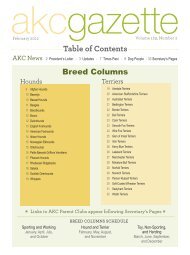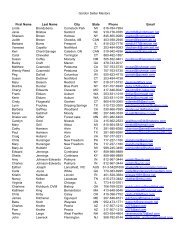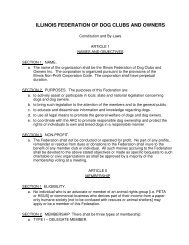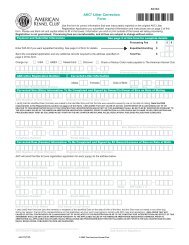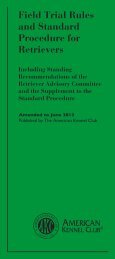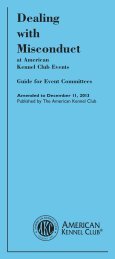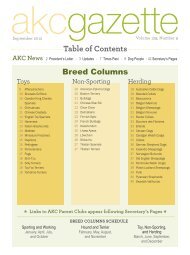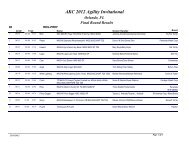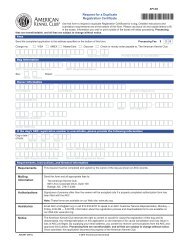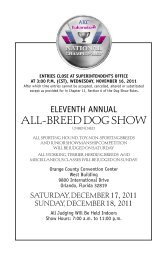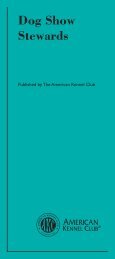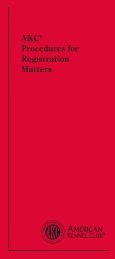Obedience Regulations - American Kennel Club
Obedience Regulations - American Kennel Club
Obedience Regulations - American Kennel Club
Create successful ePaper yourself
Turn your PDF publications into a flip-book with our unique Google optimized e-Paper software.
Section 19. Hands. in all exercises where the dog is required to heel<br />
free, one of these options should be followed: (1) when the handler is in<br />
motion, the arms and hands must move naturally at the sides and must<br />
hang naturally at the sides when stopped; or (2) the right hand and arm<br />
must move naturally at the side, while the left hand must be held against<br />
the front of the body, centered in the area of the waist, with the left forearm<br />
carried against the body.<br />
in either of the above situations, the hands and arms may be adjusted<br />
during the fast portion of an exercise in order to maintain balance.<br />
there will be a substantial deduction if the hands and arms are not<br />
carried in one of the positions stated above. in any exercise that requires<br />
a dog to sit in front, the handler’s arms and hands must hang naturally<br />
at the sides until the dog has sat in front. the handler must receive a<br />
substantial deduction for not doing so.<br />
Any movement of the handler’s hands or arms from the time the<br />
dog sits in front and prior to the dog returning to the heel position will<br />
be considered an additional signal or command and will be penalized<br />
unless such movement is otherwise permitted by these regulations.<br />
Section 20. Commands and Signals. When these regulations mention<br />
a command or signal, only a single command or signal may be given.<br />
Any extra commands or signals must be penalized. When these regulations<br />
specify command and/or signal, the handler may give either one or<br />
the other or both command and signal simultaneously. When a signal is<br />
permitted, it must be a single gesture with one arm and hand only, and the<br />
arm and hand must immediately be returned to a natural position.<br />
Delay in following a judge’s order to give a command or signal must be<br />
penalized, unless the judge directs the delay. lack of prompt response by<br />
the dog to a command or signal is subject to a penalty.<br />
signaling correction to a dog is forbidden and will be penalized. signals<br />
must be inaudible, and the handler must not touch the dog. Any unusual<br />
noise or motion may be considered to be a signal. Position of the arms and<br />
hands and movements of the head and/or body that aid the dog will be<br />
considered additional signals. A handler may, however, bend the body and<br />
knees to bring their hand level with the dog’s eyes while giving a signal to<br />
a dog in heel position. Any kind of whistling is prohibited.<br />
the dog’s name may be used once immediately before any verbal<br />
command or before a verbal command and signal when these regulations<br />
permit command and/or signal. the name will not be used with any signal<br />
not given simultaneously with a verbal command. the dog’s name, when<br />
given immediately before a verbal command, will not be considered as an<br />
additional command, but a dog that responds to its name without waiting<br />
for the verbal command will be scored as having anticipated the command.<br />
the dog should never anticipate the handler’s directions but will wait for<br />
the appropriate commands and/or signals. moving forward at the heel<br />
without any command or signal other than the natural forward movement<br />
21<br />
<strong>Obedience</strong><br />
<strong>Regulations</strong>




